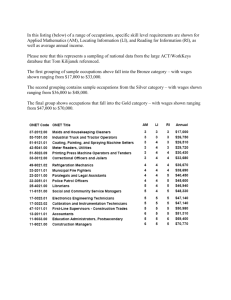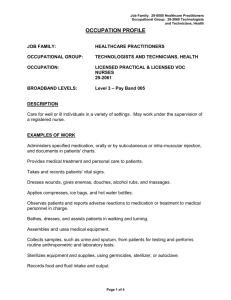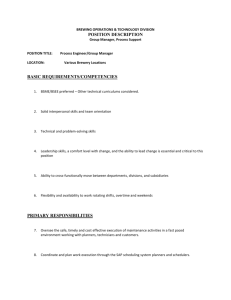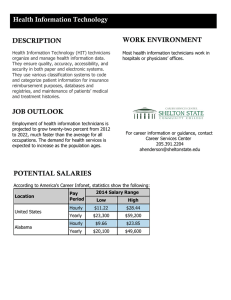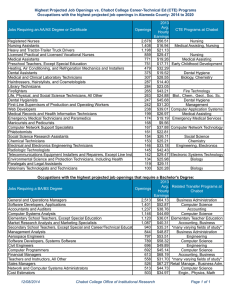Document 12295228
advertisement
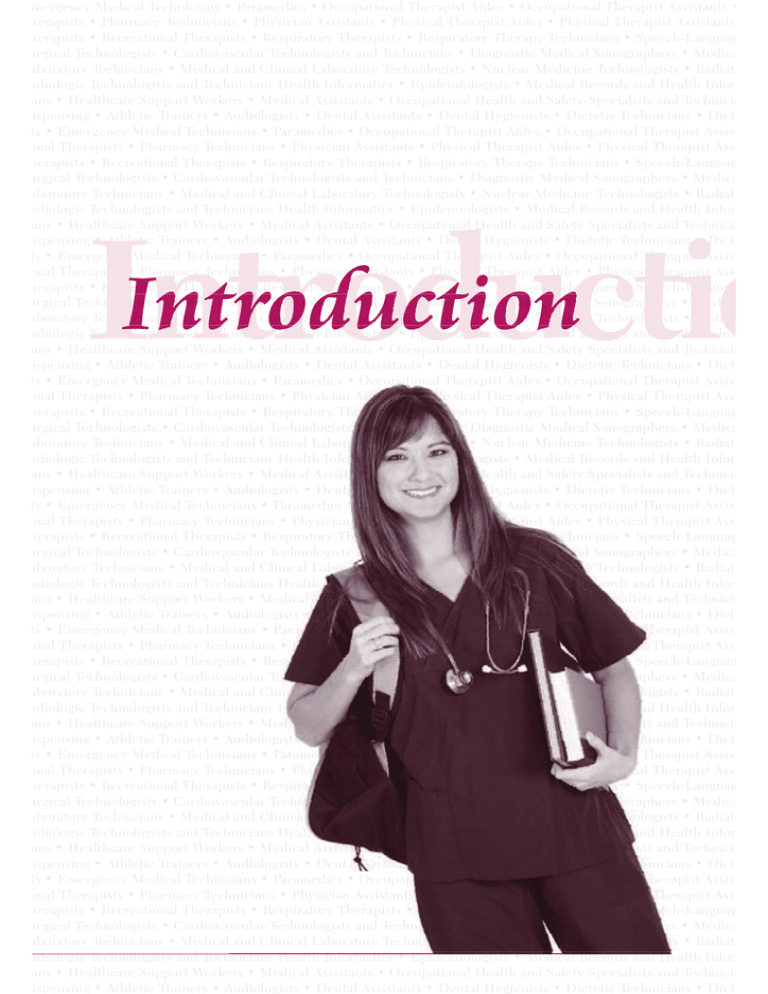
mergency Medical Technicians • Paramedics • Occupational Therapist Aides • Occupational Therapist Assistants • herapists • Pharmacy Technicians • Physician Assistants • Physical Therapist Aides • Physical Therapist Assistants herapists • Recreational Therapists • Respiratory Therapists • Respiratory Therapy Technicians • Speech-Languag urgical Technologists • Cardiovascular Technologists and Technicians • Diagnostic Medical Sonographers • Medica aboratory Technicians • Medical and Clinical Laboratory Technologists • Nuclear Medicine Technologists • Radiati adiologic Technologists and Technicians Health Informatics • Epidemiologists • Medical Records and Health Infor ans • Healthcare Support Workers • Medical Assistants • Occupational Health and Safety Specialists and Technicia ispensing • Athletic Trainers • Audiologists • Dental Assistants • Dental Hygienists • Dietetic Technicians • Diet ts • Emergency Medical Technicians • Paramedics • Occupational Therapist Aides • Occupational Therapist Assist onal Therapists • Pharmacy Technicians • Physician Assistants • Physical Therapist Aides • Physical Therapist Assi herapists • Recreational Therapists • Respiratory Therapists • Respiratory Therapy Technicians • Speech-Languag urgical Technologists • Cardiovascular Technologists and Technicians • Diagnostic Medical Sonographers • Medica aboratory Technicians • Medical and Clinical Laboratory Technologists • Nuclear Medicine Technologists • Radiati adiologic Technologists and Technicians Health Informatics • Epidemiologists • Medical Records and Health Infor ans • Healthcare althcare Support Workers • Medical Assistants • Occupational Health and Safety Specialists and Technicia ispensing • Athletic Trainers • Audiologists • Dental Assistants • Dental Hygienists • Dietetic Technicians • Diet ts • Emerrgency Medical Technicians • Paramedics • Occupational Therapist Aides • Occupational Therapist Assist onal Theraapistss • Pharmacy Technicians • Physician Assistants • Physical Therapist T Aides Aid • Physical Therapist Assi herapists • Recreational creational eational nal Therapists • Respiratory Therapists • Respiratory Therapy Techn Tech Technicians • Speech-Languag urgical Tecchnologists logists gists • Cardiovascular Technologists and Technicians • Diagnostic Medica Medic Medical Sonographers • Medica aboratory Technicians nicians icians • Medical and Clinical Laboratory Technologists • Nuclear Medicin Medicine Technologists • Radiati adiologic Technologists l i and d Technicians T h icians a s Hea Health Health In Informatics I format o atics • Ep Epidemiologists Epid dem de iologists • Med M Medical ed dical Records eco ds and a d He Health ea Infor ans • Healthcare Support Workers ers • Medical Assistants • Occupational Health and Safety Specialists and Technicia ispensing • Athletic Trainers • Audiologists • Dental Assistants • Dental Hygienists • Dietetic Technicians Technician • Diet ts • Emergency Medical Technicians cians • Paramedics • Occup Occupational up paati att ona o l Therapist Aides • Occupational Therap Therapist Assist onal Therapists • Pharmacy Technicians hnicians • Physician Assi Assistants sista sista si tants an ntt • P nts Phy Ph Physical h sical Therapist Aides • Physical Ther Therapist Assi herapists • Recreational Therapists ists • Respiratory The Therapists erap raap pist ists • Re ists R Respiratory esp sp spi piiirat r ory Therapy Technicians • Speech Speech-Languag urgical Technologists • Cardiovascular scular Technologists an and and d Te T Technicians echn ch hn nic icciiaans ici an n ns • Diagnostic Medical Sonographers • Medica aboratory Technicians • Medical and Clinical Labora Laboratory atoory ato ry Tec T Te Technologists ec ech hno no n log llooggis ist stts • Nuclear Medicine Technologists • Radiati adiologic Technologists and Technicians hnicians Health Infor Informatics rrm mati atics at css • E Epidemiologists pid id dem miiolo m ollogists lo lo • Medical Records and Hea Health Infor ans • Healthcare Support Workers ers • Medical Assistants Assistaaant nts • Oc Occup Occupational cupati cup cu pati a on on naal H Health and Safety Specialists and Technicia ispensing • Athletic Trainers • Audiologists • Dental Dentaaall Assistants As A sis istan an nts ts • D Dental en en nttall Hygienists Hygienists • Dietetic Technicians Technician • Diet ts • Emergency Medical Technicians cians • Paramedics • Oc O Occupational ccu cup up pati a onaal T at Therapist her errapi ap pisstt Aides • Occupational Therap Therapist Assist onal Therapists • Pharmacy Technicians hnicians • Physician A Assistants ssista sssi stan taants nttss • Phy nt Physical hysic s al si al Th The Therapist heerap h rap ra apist Aides • Physical Ther Therapist Assi herapists • Recreational Therapists ists • Respiratory The Therapists heera rapist rap apis ist sts • Respi R Respiratory esp piirrat raaattory ryy Th Therapy herapy eraapyy Te Tec T Technicians eechnicians • Speech Speech-Languag urgical Technologists • Cardiovascular scular Technologists and an nd Te n Technicians echn ch hniic ici ccians an ns • D Dia Diagnostic iaggno ia gn nosti stic tiic M Medical edi ed diical d c Sonographers • Medica aboratory Technicians • Medical and Clinical Labor Laboratory orraato orato ttoory ry Techn Tec Te Technologists e hn hno h noolog l ist stss • N Nu Nuclear ccleear ar Me Med Medicine ed dici cn nee Technologists • Radiati adiologic Technologists and Technicians hnicians Health IInf In Informatics nf nform o ati orm a cs • E Epid Epidemiologists pid pi pid demi miiolo olo ol logis gis gists ists ts • M Medical edi d cal di c Re ca Recor Records ec ds and Hea Health Infor ans • Healthcare Support Workers ers • Medical A Ass Assistants ssist sstaant n nts • O Oc Occupational cu cup cupati upationa u atiioon ona nal H n Health e th eal ea h an aand n nd Sa S Safety afet ety S ety et Specialists pec pe ecialists and Technicia ec ispensing • Athletic Trainers • Audiologists • Dental Den en ntal all Assistants As Assis siisstan t ts ts • Dental Dent Den ental al Hygienists Hyyygien Hyg H en niist ssts • Dietetic Dieete Di ttetic Technicians Technician • Diet Te ts • Emergency Medical Technicians cians • Param Paramedics meedic m iccs • Oc Occupational ccu cup upaati up ti t oon ona naall T na Therapist herapi her pistt Aid pi Aides id deess • O Occupational ccu cupat pat p atio ion onal al The T Therapist rap Assist onal Therapists • Pharmacy Technicians hnicians • P Ph Physician hysi ysicia ccia iaan A Assistants ssi siista sttaan ntts • Phy nts Ph Physical hysic s al a T Th The Therapist herap ap pist iisstt Aides Aiides d • Phy de Physical hysic ssiccaall Ther Therapist Assi herapists • Recreational Therapists ists • Respiratory Resp pir pi p iratory ator T The Therapists heerap erap ap pist ists • R is Re Respiratory espi piirat ratooryy T Th Therapy her erap era pyy T p Technicians ecchni hni h hn n cia cian nss • S n Speech-Languag peech urgical Technologists • Cardiovascular scular Tech Technologists chn cch hn h olo ologgi gis istss and nd Tec nd Te Technicians chn cch hnici ic ans an nss • Dia n D Di Diagnostic iagno gnost st c M sti Medical edi ed diical d ical all S So Sonographers onog noggra r hers • Medica rap aboratory Technicians • Medical and Clini Clinical ical call La L Laboratory bor bo oraat attoory ry Te T Tec Technologists e hno hnolog hn logist log oggists ist sts • Nu st Nucle Nuclear clea lear ar Me M Medicine edicci cine T Te Technologists eecchnoolog l ists • Radiati adiologic Technologists and Technicians hnicians H Health e lth eal t Inf th Informatics for orm rmat ati tticss • E Epidemiologists pid demi emiolo oolo l gis gists ts • M Medical eedi d dicall R Records eecor coords cor ds an and nd Hea Health Infor ans • Healthcare Support Workers ers • Medical Medic ical ic al Ass Assistants sis ist ist stant a s•O an Oc Occupational cup up patiiona on l H Health eal a th and an nd Sa Safety afetty S Specialists peeciial pec alissts and Technicia ispensing • Athletic Trainers • Audiologistss • Dental Deen De ntal t Assistants Assssis i tan nts t •D Dental ent ntal all Hygienists Hyg y ien ieenistts • Dietetic Diiete e ttic iic Technicians Technician • Diet Te ts • Emergency Medical Technicians cians • Paramed Paramedics dic di d i s•O Oc Occupational ccu ccup upaati tionaal T Therapist herapi her apiist s Ai A Aid Aides es • O Occupational ccu cupa up pat pa aation onaal on al Therap Therapist Assist onal Therapists • Pharmacy Technicians hnicians • Phys Physician yyssi sicia c nA ci Assistants ssist ssi sta st tantts ts • Phy Physical ysic si all The Therapist h rrap apist A Ai Aides ides des • Phy P Physical hyysical sic ic Ther Therapist Assi herapists • Recreational Therapists ists • Respiratory Respirat atttooryy The ato Therap Therapists ra ist rap sts • R Re Respiratory espi sp pirat p ratory ory Th Therapy hera rapy p Tec py Techni Technicians ecchni hn h ni nicia cia ci i ns • Speech Speech-Languag urgical Technologists • Cardiovascular scular Techno Technologists oolo llogis g stss and a Te Techn Technicians ch ic ici cians aanss • Dia an Di Diagnostic agno g stiic M Medical edi d ccall So di S Sonographers nographers • Medica no aboratory Technicians • Medical and Clinicall La L Laboratory abor borat bo atory ato ry Tec Tech Technologists hnoolo log oggiist s s • Nu N Nuclear cl aarr Med cle Medicine dicine ici cinee Tec Technologists ecchno hn n logists • Radiati adiologic Technologists and Technicians hnicians Health th h Inf Inform Informatics ormati orm aticss • E ati Epidemiologists pidemi pid emi em m olo mi o gis gists ts • Medi M Medical ediical ed c Re ca R Records corrdss and co a Hea Health Infor ans • Healthcare Support Workers ers • Medical Assist Assistants tant an nts • Oc Occup Occupational cupati cup ationa ona on nal Heal H Health ea th and Sa eal Safety afet f y Spec S Specialists peccia ial allist i s and Technicia ispensing • Athletic Trainers • Audiologists • Dentall Assistants Assistan A tan ta ants • Dent an Dental Den ent ntal Hygienists Hygien Hyg ien enist istss • Dietetic D Di Diete eteetic et t Technicians ti Teecch chn h ician • Diet ts • Emergency Medical Technicians cians • Paramedics • Occupati Occupational iona onal T Therapist herapi herapi her apist stt Aid A Aides ides id des • Occu O Occupational ccu upattion i al T Therapist herap Assist onal Therapists • Pharmacy Technicians hnicians • Physician Assistants • Phy P Physical hyysic sical all The Therap Therapist rapist rap i A ist Aides ides des • Phy Ph Physical hysic sicall The T Therapist r Assi herapists • Recreational Therapists ists • Respiratory Therapists • R Respiratory espi spirat sp rat a ory or Thera Th Therapy erap era py Tec py T Techni Technicians e h hni niccia i ns • S Speech-Languag peeeeech p urgical Technologists • Cardiovascular scular Technologists and Technic Technicians iccians ici ic nss • Dia D Di Diagnostic gnosti gno sticc M sti Medical eedi dicca cal a So S Sonographers nograp nog raphe heers • Medica aboratory Technicians • Medical and Clinical Laboratory Technologists Technolog loo ist llog s s • Nu st Nucle Nuclear clear cle ar Med Medicine edici ed icine nee Tec T Technologists e h hno nolog ogis issstts • Radiati adiologic di l Technologists and Technicians h i i H Health lth IInformatics f ti • E Epidemiologists id d i l i •M Medical di l R Records d and dH Health Infor ans • Healthcare Support Workers • Medical Assistants • Occupational Health and Safety Specialists and Technicia ispensing • Athletic Trainers • Audiologists • Dental Assistants • Dental Hygienists • Dietetic Technicians • Diet Introduc Introductio Background The allied health field is multidisciplinary, and the choices of scope and methodology made to assess supply and demand by the authors are described in this section. The background describes the objectives, rationale, scope, and methodology of the study and the organization of the report. Allied health supply and demand data are not always comparable for the various professions, and some sources of data are not widely available. The diversity and number of fields in allied health contribute to recruiting difficulties as well as gathering consistent occupational and other data. The multiplicity of credentialing and accrediting organizations also adds complexity. The recommendations following the analysis of supply and demand are not definitive since data sources are often not in agreement, and factors that affect supply and demand in the health care field are varied and changing. Also, in some fields, the demand is for replacement workers rather than a reflection of overall job growth, and sometimes the expressed demand is a combination of these two factors. Constant monitoring of external conditions and constraints is necessary to ensure that academic programming is responding to student, marketplace, and societal needs. The report identifies sources of data that institutions can use as they assess program needs. For example, the Bureau of Labor Statistics Occupational Outlook Handbook is a standard source. This report is being made available generally in the belief that it will be of interest to others involved in the education, training, and employment of allied health professionals and that it will be a resource for career counseling and advisement. The report describes the employment status of various allied health professions at the national and state levels, provides current supply information at the state level, identifies areas of need, and gives general state and national employment projections. Earlier editions also reported regional program data, but the SREB (Southern Regional Education Board) no longer reports data by allied health programs in the same way as in the past. Some regional data may be found by searching individual state data as reported by state departments of education or workforce development, healthrelated agencies, or national associations and organizations for specific professional areas. 2 In recent years, states including Tennessee have developed programs and Web sites to assist students in identifying possible careers. Health science is one such career cluster (www.state.tn.us/ labor-wfd/Publications/EmploymentSecurity/CareerCluster/Health. pdf), and, additionally, high school programs of study are linked to career options (http://pathways.tbr.edu). Objectives of the Study This report is the fourth edition of a study originally requested in 1993 by the chancellor of the Tennessee Board of Regents (TBR) to determine supply and demand for allied health programming in Tennessee. A task force of TBR allied health faculty and staff members was charged to develop the original report. (See Appendix H for a list of task force members.) Many changes have occurred since the original report in 1993, most notably the implementation of TennCare. A reassessment of the supply and demand for allied health professions in Tennessee in 2000, 2004, and 2010 provides an opportunity to look at trends. Many of the same data sources were used for all editions and new sources have been added as they have become available. Allied health is a high-cost academic area that has significant implications for the quality of life of Tennessee citizens. In times of economic uncertainty and fiscal constraint, changing demographics, and technology, postsecondary institutions and their partners in the health care industry must carefully plan to meet public needs and expectations for improved health care. What Is Allied Health? The designation of “allied health professional” encompasses individuals in health care settings who provide diagnostic, therapeutic, support services, or work in health informatics and biotechnology research and development. Generally, anyone working in a health-related field who is not identified as a doctor or a pharmacist or a nurse is likely to be an allied health professional. There are over 200 categories of allied health professionals, and they often have extended contact with patients and play a crucial role in producing positive health outcomes. 3 Allied health practitioners have formal education and clinical training and are credentialed through certification, registration, and/or licensure (www.healthpronet.org/students/html). According to the BLS (“Occupational Employment Projections to 2018,” Monthly Labor Review, November 2009), health care practitioners and technical occupations are projected to add 1.6 million jobs between 2008 and 2018, a growth rate that is nearly “twice as fast as the average for all occupations,” a 21 percent increase. Health care support occupations are projected to grow by 29 percent during the 10-year period. Tennessee Metropolitan Statistical Areas in the Top 100 U.S. Labor Markets 2008–2009 The economy may be struggling, but hiring continues in health services and education, which has added almost a quarter-million jobs in the nation’s 100 biggest labor markets between June 2008–2009. As a whole, the group of 100 has added 232,600 jobs in the fields of education and health since mid-2008 representing a gain of 1.8 percent. Tennessee Metropolitan Statistical areas (MSA) included in the Top 100 U.S. Labor Markets with related gains in health services and education jobs from June 2008–June 2009 are as shown below. MSA: Gain in Number of Jobs in Health Services and Education June 2008–June 2009 Knoxville 200 Chattanooga 400 Nashville 900 Memphis 1,900 Source: Puget Sound Business Journal, Seattle, Washington, August 11, 2009, reporting data from the U.S. Bureau of Labor Statistics. Estimates for non-farm employment in MSA and subMSA areas can be found on page 167. The category of personal and home care aides, which requires shorter terms of training, is projected to show a 50 percent growth rate. This growth will be fueled by an increase in home care, shorter institutional stays, and a growing elderly population. 4 Rationale for the Study Health reform, past and proposed, has significant effects on programs that prepare health professionals. The increased use of nurse practitioners and physician assistants to provide primary care is a good example of the impact of the changing health care management system. Additionally, certified assistants and aides now provide increased amounts of quality care to patients, reducing the demand for health professionals prepared at the master’s and doctoral levels. Delivery systems, payment systems, and levels of care required by federal and state programs all affect the demand for various health care disciplines and the levels of training required for them. Allied health workers are being asked to be more flexible and to perform a variety of tasks (multiskilling), and educators are challenged to keep the curriculum up-to-date in an environment of constant change. The implementation of TennCare had a tremendous impact on allied health. When the state’s Medicaid beneficiaries were switched to a managed care system in 1994, 50 percent more individuals were covered for the same cost. Managing growth has been and will continue to be a challenge for TennCare. The increased number of those served without a corresponding increase in the budget has had an impact on all health care workers and specifically on allied health professionals as their scope of services changes. Academic studies are relevant because they often influence state policy decisions and workforce initiatives. In 1989 a Tennessee Board of Regents study, “Nursing in Tennessee,” indicated a shortage of nursing personnel, and the system responded by approving additional programming. A June 2009 report by the Tennessee Center for Nursing, “Forecasting Supply, Demand, and Shortage of Nurses in Tennessee,” noted that in 2004 the projected shortage of RNs was 35,000. The current projections are not as severe but are still significant: a shortage of 2,800 in 2008 that will grow to nearly 15,000 in 12 years (www.centerfornursing.org/currentresearch.htm). The State of North Carolina also worked to identify allied health demand through reports in May of 2005, 2006, 2007, and 2008. These reports focused on tracking vacancies by reviewing classified advertisements to identify need. 5 The demand for allied health practitioners reflects the trend in the health care industry for additional assistants and technicians, under the supervision of therapists, to perform more of the procedures that therapists have performed in the past. For example, while the BLS projects a growth rate of 15.6 percent (2008–2018) in the number of dentists, the number of hygienists and dental assistants is projected to grow at a 36.1 percent rate (2008–2018). The distribution of workers in health care practitioners and technical occupations is also changing, with more jobs opening up in offices of health practitioners, in home health services, and in individual and family services, rather than in costly in-patient facilities such as hospitals. In Tennessee, allied health represents a large and increasingly important employment sector and an engine for economic growth. Between 2003 and 2008, allied health employment in Tennessee grew 24.3 percent. Overall, health care jobs grew 18.25 percent, and total employment grew 5.44 percent. In 2008 in Tennessee, allied health professions comprised 34 percent of the health care jobs compared to physicians at 4 percent; RNs at 25 percent; LPNs at 10 percent; and nurse aides, orderlies, and attendants at 23 percent. An extensive review of specific health science occupations and a high-skill, high-wage, high-demand matrix is published by the Tennessee Department of Labor and Workforce Development at “The Source” (www.sourcetn.org). Annual median wage and numbers of projected new jobs are also presented. “The Source” is the most comprehensive and user-friendly source of labor market data in the state. It also provides information about nearly 92,000 Tennessee employers. In 2002, the THA received federal funding to initiate the Center for Health Workforce Development in Tennessee. The center was established to achieve an abundant, competent, and motivated health care workforce through statewide collaborations, strategies, and solutions. The Center for Health and Human Services at MTSU, which produces this report, and the Tennessee Center for Nursing are part of the advisory committee of the Center for Health Workforce Development (www.healthworkforce.org). In the allied health area, Tennessee offers more than 139 programs at all levels, from area vocational technical schools to two- and four- 6 year schools. (See Appendix A for a list of programs by school.) These programs have both credit and noncredit offerings and range from certificate- to doctorate-level. Some programs are based on a partnership model, with clinical instruction delivered by other educational and medical institutions outside the higher education system. Scope of the Study The original study covered selected occupations in the allied health field that were grouped into three health care and occupational clusters as identified by the National Health Care Skills Standards Project (Far West Laboratory, 1995). The new study reflects the clusters as identified by the Tennessee Department of Education’s and the Tennessee Board of Regents’ Tennessee Career Cluster Guide for 2008–09 (www.state.tn.us/labor-wfd/Publications/ EmploymentSecurity/CareerCluster/Health.pdf). These clusters are consistent with the health science career clusters taught in Tennessee high schools (http://pathways.tbr.edu) and also reflect career technical education categories from the Tennessee Department of Labor and Workforce Development (http://www.state.tn.us/labor-wfd/ Publications/EmploymentSecurity/CareerCluster/Health.pdf). “Therapeutic” professionals provide treatment and work on maintaining and/or changing patient health status over the long term; “diagnostic” professionals create a picture of client health at a single point in time; “informatics” professionals document client care, and “support” professionals provide services that support the work of others on the health care team. Each allied health profession in this study is included in one of these clusters according to primary function. Therapeutic Services The rehabilitation field includes physical therapy, occupational therapy, physical therapy assisting, occupational therapy assisting, athletic training, recreational therapy, speech-language pathology and audiology, respiratory therapy, dietetics, and surgical technology. Other occupations in the therapeutic services cluster include physician assisting, emergency medical services, and dental services. 7 Diagnostic Services The medical imaging field includes diagnostic radiologic technology, radiation therapy, nuclear medicine technology, and diagnostic medical sonography. The clinical laboratory services field includes clinical medical technology, clinical medical laboratory technology, and phlebotomy. The dental services field includes dental hygiene and dental assisting. Health Informatics The health information services field includes health information administration, health information technology (formerly medical records administrators and managers), medical transcription, and epidemiology. Support Services The “support services” field includes all health care support workers including medical assisting and nursing assisting. Educational Guide Projected growth is reported in some occupational areas, although factors used to predict future growth—such as repayment systems and level of access—are rapidly changing. The supply and demand information presented in this report will be useful as a student counseling guide as well as a guide for higher education and for employers. Labor market factors such as supply and demand are only one part of the academic program planning and decision-making process. Allied health programming must be evaluated in the context of an institution’s overall mission. As an institution pursues its academic goals, a number of factors must be analyzed and considered including a variety of academic programming needs; student interests; the availability of qualified faculty; accessibility to appropriately equipped classrooms, laboratories, and clinical education sites; accreditation fees and other recurring costs; and the program mix of the institution. 8 Methodology This section presents the six research questions that guide the study and briefly describes the supply/demand data sources that were used. Research Questions 1. What is the supply of selected allied health personnel from Tennessee schools? 2. What is the demand for various allied health care professionals in Tennessee? 3. What is the relationship between the Tennessee supply and the national supply of allied health professionals? 4. What is the relationship of the Tennessee demand to the national demand? 5. If the demand is greater than the supply, what are the recommendations to address this situation? 6. Where can students be directed for health career planning? The answers to the first four questions are found in the occupational report. The recommendations given in answer to question five are found in the status summaries. The references and appendices respond to question six. 9 Issues Surrounding Allied Health Supply and Demand Studies and Data As the Institute of Medicine (IOM) study noted (1989), the allied health field “comprises occupations with varying labor market characteristics,” including levels of education and responsibility, work sites, paths of entry, wages, and job titles and descriptions; therefore, each occupation must be considered separately. The diversity of the fields and the lack of federal investment to establish national databases contribute to the lack of consistent national data (IOM, 1989, p. 445). Although several projects have been initiated to address these data issues, such as the Hidden Health Care Workforce, 1999; the Health Professions Workforce Data Collaborative Project, 1999; and the 2001 funding of four regional Centers for Health Workforce Studies by HRSA (http:/bhpr.hrsa.gov/ healthworkforce), these observations still hold true in 2010. Demand, if expressed as “need,” quickly becomes a qualitative question. For example, how many respiratory therapists are “needed” to provide a “quality” level of health care for Tennesseans is a different question than how many respiratory therapy positions are currently available. The definition of demand as identified by “The Source,” Tennessee Department of Labor and Workforce Development, was used instead of attempting to survey qualitative need. Demand was determined by looking at the growth rate and job openings expected. Demand was also determined in some fields by hospital vacancy rate data. According to the BLS, allied health professions are generally expected to grow faster than the average for all occupations through 2018. In some disciplines, there are more program completers than there are expected job openings. This situation is described as a competitive market. Supply and demand are not always perfectly balanced geographically and local demands may change within a short period of time. As with previous editions, this study (1) used primarily existing data, (2) selected several allied health fields to study in depth, (3) identified “demand” rather than “need” in looking at health care, and (4) took into account general trends and available data to make a “best guess” at recommendations for programming and student recruitment. 10 Description of Supply and Demand Data Types The description of national, state, and local data sources is intended to assist the reader in evaluating the data. Institutions and others who would consider proposing additional programming in this area may use these sources. Counselors for career guidance can use them for students; human resource offices can use them to identify potential sources of graduates. While the information contained in this document will be useful to institutions as they consider program planning, other considerations must also be a part of the process. Some local data is available as part of this report in the appendices, including servicearea data. Regional and service area needs assessments must be made to ensure a long-term demand for program graduates as local demands may change in a short period of time and may not always reflect state work force data. The authors urge institutions to make use of the data sources identified to help assess need. Local surveys of employers, careful attention to technological advances, and tendencies of local populations to avail themselves of health care opportunities must also be considered. All data sources in supply and demand studies have strengths and weaknesses. No single source should be used as a determining or deciding factor. To increase reliability and validity, a variety of sources must be considered in this type of study, and conclusions should be made based on aggregate information from within an occupational area and across several areas. Occupations Not Included in This Study Public health, health services administration, opticians, community health education, music therapy, cardiopulmonary technology, orthotic/prosthetic, pharmacy assistant, substance abuse, and environmental health are areas that may be considered allied health, but they are not included in this study. We have excluded the preprofessional categories such as premedical because students often transfer to other institutions for professional programs. 11 Institutions of Learning Included in This Study Proprietary institutions that have earned programmatic accreditation are included in this study and are referenced where appropriate. It is beyond the scope of this project to be inclusive of all proprietary institutions. Four Sources Used in this Study 2008-2018 National Bureau of Labor Statistics Projections of Supply and Demand in the Allied Health Professions Every other year the U.S. Department of Labor’s Bureau of Labor Statistics (BLS) publishes its employment outlook for a tenyear period. The latest BLS projections, which are for the period 2008-2018, were released on December 10, 2009. For many of the allied health professions covered in this publication, those data are reflected in Appendix G, page 183. The BLS data are a primary source of information about the demand for allied health professionals. The ten-year BLS projections constitute national data and estimates of employment need, but national data may be of somewhat limited help when attempting to assess what the local or regional need will be over such an extended period of time. Health care is primarily a local market and there will sometimes be significant differences not only from one state to another, but among sub-state regions and local areas as well. Population density, location and number of health facilities, location of educational programs, location of four-year institutions, and the program mix and number of graduates of the educational institutions all contribute to variance from one geographic area to another. The latest BLS projections for 2008-2018, as was true for the previous 2006-2016 projections, show continued strong growth in the health professions and occupations. With a growth rate of 10.1 percent in overall U.S. employment during the 2008-2018 period, the category of “health care practitioners and technical occupations” is projected to grow over twice that rate at 21.4 percent, with the 12 “health care support occupations” projected to grow almost triple the overall rate at 28.8 percent. The Tennessee Department of Labor and Workforce Development Through “The Source,” the most comprehensive and userfriendly source of labor market data in the state, the Tennessee Department of Labor and Workforce Development provides a variety of labor market information and data. The interactive system contains a vast amount of information covering areas such as job demand, economic indicators, wages, census data, and education/training programs. It also provides information on nearly 92,000 Tennessee employers. Area profiles are also available by local workforce investment areas, metropolitan areas, and counties. The Tennessee Department of Labor and Workforce Development produces “The Labor Market Report,” which includes estimates of employment and rates of change for the 2008 and 2009 years for educational and health services professions. Data indicate that statewide, all non-farm employment decreased by 13.2 percent, while educational and health services increased by 9.7 percent from 2008-2009. Data are provided by metropolitan statistical area (MSA), with each MSA showing decreases in all non-farm employment, and increases in educational and health services employment for all but two MSAs (Appendix D). Joint Annual Report of Hospitals, Tennessee Department of Health, Vacancy Rates The Joint Annual Report of Hospitals indicates a need for selected allied health personnel based on vacancy rates, with some Tennessee Hospital Association districts and individual counties having greater needs than others. For 2008, statewide vacancy rates were greater than 4 percent for occupational therapists (9.7 percent) and for physical therapists (7.8 percent). Data are provided for medical technologist, radiologic technologist, surgical technologist, occupational therapist, physical therapist, and respiratory therapist. While not all allied health occupations are included in this data set, hospitals employ 60 percent of allied health workers. Therefore, these figures may correlate well with other allied health professions. Data by hospital district and by county are available (see Appendix D) to assess need at the regional and local levels. 13 2008 Population Ratio Data Population ratios are broad measures of provider densities for selected occupations. Data from the U.S. Bureau of Labor Statistics and the Tennessee Department of Labor and Workforce Development indicate for some professions a population ratio for the state that is less than that of the United States. This data should be used with caution and not in isolation, however, as there are multiple factors that influence whether the supply of providers is appropriate. Occupational therapy, occupational therapy assistants, speech language-pathologists, dental hygienists, dental assistants, and physician assistants each had lower population ratios than that of the nation. There were other professions such as athletic trainer, recreational therapist, dietitian, and epidemiologists with slightly lower population ratios than that of the nation. Population ratios for each of the selected professions are included as Appendix F. 14 Em Th Th Su La Ra cia D ist tio Th Su La Ra cia D ist tio Th Su La Ra cia D ist tio Th Su La Ra cia D ist tio Th Su La Ra cia D ist tio Th Su La Ra cia D ist tio Th Su La Ra cia D ist tio Th Su La Ra cia D

